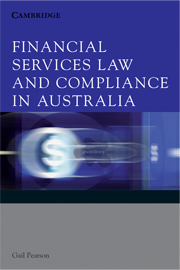Book contents
- Frontmatter
- Contents
- Preface
- List of Abbreviations
- Table of Statutes
- Table of Cases
- 1 The financial citizen and the market
- 2 The regulatory structure
- 3 An overview of financial services reform
- 4 Licensing financial services providers
- 5 The role of disclosure in the distribution of financial products
- 6 Selling financial products and other conduct
- 7 Deposit-taking and payments
- 8 Investment
- 9 Insurance
- 10 Consumer credit
- 11 Superannuation
- 12 Compliance, enforcement and remedies
- Index
- References
4 - Licensing financial services providers
Published online by Cambridge University Press: 05 June 2012
- Frontmatter
- Contents
- Preface
- List of Abbreviations
- Table of Statutes
- Table of Cases
- 1 The financial citizen and the market
- 2 The regulatory structure
- 3 An overview of financial services reform
- 4 Licensing financial services providers
- 5 The role of disclosure in the distribution of financial products
- 6 Selling financial products and other conduct
- 7 Deposit-taking and payments
- 8 Investment
- 9 Insurance
- 10 Consumer credit
- 11 Superannuation
- 12 Compliance, enforcement and remedies
- Index
- References
Summary
Licensing ‘is to promote consumer protection’.
The purpose of licensing
Licensing is a way to safeguard who provides financial services, and imposes standards so that financial promises are reasonable and are kept. It can provide for ongoing supervision and can reduce risk for clients, but it may also be a source of risk to regulators. Licensing also allows the regulator to remove ‘bad apples’ from the system. It is supposed to reassure consumers and create the conditions for a competitive and fair market. The objectives of licensing include the financial soundness of the provider, competence, honesty and fairness, and the quality of performance. There is a difference between regulating events that have happened and filtering proposed activities. The former rests on detecting prescribed conduct and requires extensive monitoring. The latter requires permission to undertake an activity and provides the regulator with the opportunity to impose conditions or standards on the proposed activity. Positive licensing clearly involves screening by the regulator before the activity commences. When licence obligations can be both screened and later monitored for compliance, licensing is a powerful regulatory tool. The regulator has considerable economic power when conduct of business rules, individual probity standards, disclosure obligations and conduct standards are linked to gaining and retaining a licence.
Many industries in Australia are subject to occupational licensing as a means of ensuring that suppliers or providers satisfy desirable minimum and uniform requirements. This is true of the professions, trades, and businesses such as travel agents and motor dealers.
- Type
- Chapter
- Information
- Financial Services Law and Compliance in Australia , pp. 104 - 147Publisher: Cambridge University PressPrint publication year: 2009
References
- 1
- Cited by



